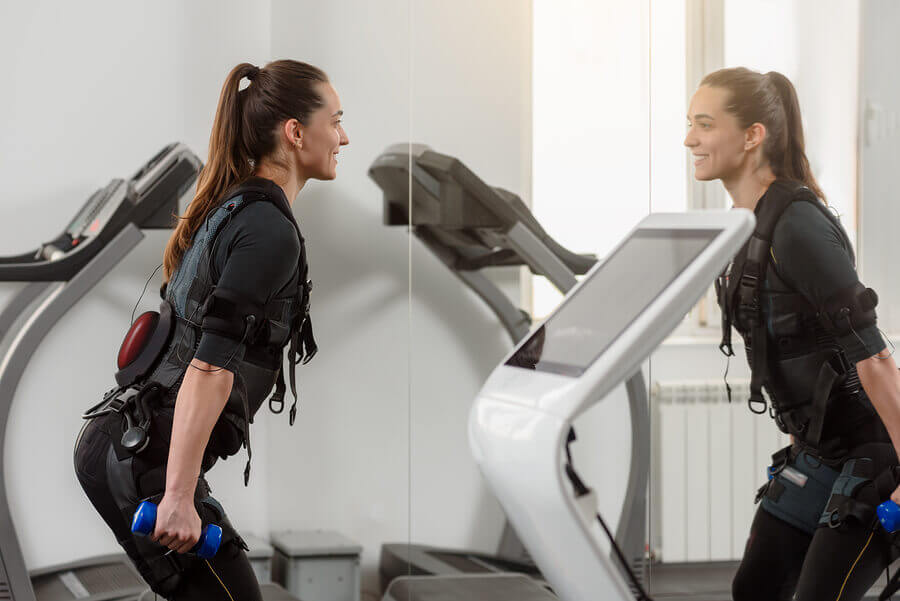Electrostimulation Training: what is it?

Electrostimulation training is a sports technique that for a long time, was reserved for elite athletes.
Nevertheless, technology has come a long way and currently, this kind of training is offered to any athlete who wishes to use it, provided that they meet certain physical conditions.
The basis of electrostimulation training is creating muscle contractions by applying small electrical impulses.
Because “traditional” training also causes muscle contractions, electrostimulation makes it possible to get in better shape and strengthen muscles in a short amount of time, without necessarily moving.
Throughout this training, the same contractions needed for great physical activity are concentrated with minimal effort on the athlete’s part.
Electrostimulation training has been considered a kind of ‘simulated exercise’ with high-intensity intervals and effects very similar to HIIT routines.

Because of this, these special routines allow athletes to strengthen muscle tone and prevent sagging. On the other hand, they also promote an increase in measurable volume, tone, strength, and resistance throughout your body.
The history of electrostimulation training
Electrostimulation training has been around for more than 50 years. In fact, in the seventies, many research teams were experimenting with the healing power of this kind of training among recovering athletes!
Of course, throughout its history, this type of training was used in rehabilitation and recovery therapies. Because of this, fitness applications of electrostimulation weren’t a common sight.
Nevertheless, nowadays electrostimulation training has been adopted into many fitness routines. Many electrostimulation devices have also appeared on the market ready to use!
What’s electrostimulation training all about?
This training consists of applying electric current over specific areas of the body through a special device. This energy causes a series of contractions in the muscles. This is a similar effect to the impulses the central nervous system sends when actually doing physical activity.
In a single 20-minute session, you could burn up to 1,200 calories. At the same time, you’re pushing your body to full capacity. This also means that your muscles will remain active for more than 72 hours after the end of the training.
Because it can act as an intense workout, not everybody can use it. In order to avoid health issues and diminish your risk of injury, you should only use electrostimulation after following some kind of workout routine beforehand. You should only try this training if you already follow a steady workout routine.
Even though it isn’t immediately noticeable, through this training you’ll go through to a high-intensity workout. For this same reason, researchers recommend limiting these ‘work sessions’ to twice a week on non-consecutive days.
How to use electrostimulation training
The key to success is to accompany this technique with a routine of active exercises. It’s not magic, nor a miraculous technique. Sitting on a couch to watch TV with the idea that only electromagnetic impulses will do all the work won’t give you any positive results!
On your “rest days” from electrostimulation, you should do some kind of physical activity to strengthen your muscles.
In addition to maintaining a balanced diet, it’s also important to take care of hydration. In the same way as with traditional physical conditioning methods, the body can declare itself in an emergency due to lack of water.
The pros and cons of electrostimulation
Are you interested in testing electrostimulation to improve your training routine?
Advantages
Alongside a ‘traditional’ exercise routine, electrostimulation training brings many benefits to the body. For starters, it helps to prevent muscle atrophy.
Because of this, you can use electrostimulation in rehabilitation to treat muscle pathologies. It also improves and prevents tissue contractures.
On the other hand, electrostimulation promotes greater muscle activation and better fiber contraction. This is because you’re targeting all tissues contracting at the same time. You might get a more complete workout than when you train all by yourself.
In addition to all of this, electrostimulation works as a treatment against pain and to treat blood clots.
On the other hand, among pro athletes, this is a common technique used to train without causing any type of fatigue in the nervous system.
Disadvantages
One of the reasons why we cannot proclaim electrostimulation as a great training option for everyone is that it doesn’t exercise motor coordination.
When doing any other kind of physical activity, you aren’t only training your muscles, but also your brain, to make your body move however you want to. In order to achieve a healthier life, you need to develop not only your strength but also a healthy range of motion. You can only accomplish a good range of motion through “traditional” workout routines.

Image: Gremyo.com
Beyond this, using electrostimulation excessively can cause many issues. This is because of how the treatment works: it only stimulates muscles.
In turn, this can strengthen your muscles but can also make tendons and ligaments weaker. This situation aggravates your risk of injury even when only doing light physical activity, such as walking.
When NOT to use electrostimulation training
As we mentioned, this type of training isn’t suitable for everyone. This is the case even if you have a good physical condition and you pair electrostimulation with other training.
If you want to use this as a therapy to regenerate your muscles or overcome injuries, your best bet is to talk to a physician first and see what they think about it.
On the other hand, electrostimulation training isn’t for those who suffer from epilepsy, have active implants such as pacemakers or present superficial wounds that haven’t healed. People who’ve suffered pronounced tumors and varicose veins should consult with a doctor before trying this kind of workout.
Finally, keep in mind that you should pause the treatment immediately in case of fever and/or bleeding processes. The same goes if you notice any inflammation or tendinitis after a treatment.
If you’re pregnant, check in with your doctor before trying this or any other workout, and make sure you avoid using electrostimulation in the abdominal area.
In the end, do what feels best for you, and always consult with a doctor before trying any new workout!
Electrostimulation training is a sports technique that for a long time, was reserved for elite athletes.
Nevertheless, technology has come a long way and currently, this kind of training is offered to any athlete who wishes to use it, provided that they meet certain physical conditions.
The basis of electrostimulation training is creating muscle contractions by applying small electrical impulses.
Because “traditional” training also causes muscle contractions, electrostimulation makes it possible to get in better shape and strengthen muscles in a short amount of time, without necessarily moving.
Throughout this training, the same contractions needed for great physical activity are concentrated with minimal effort on the athlete’s part.
Electrostimulation training has been considered a kind of ‘simulated exercise’ with high-intensity intervals and effects very similar to HIIT routines.

Because of this, these special routines allow athletes to strengthen muscle tone and prevent sagging. On the other hand, they also promote an increase in measurable volume, tone, strength, and resistance throughout your body.
The history of electrostimulation training
Electrostimulation training has been around for more than 50 years. In fact, in the seventies, many research teams were experimenting with the healing power of this kind of training among recovering athletes!
Of course, throughout its history, this type of training was used in rehabilitation and recovery therapies. Because of this, fitness applications of electrostimulation weren’t a common sight.
Nevertheless, nowadays electrostimulation training has been adopted into many fitness routines. Many electrostimulation devices have also appeared on the market ready to use!
What’s electrostimulation training all about?
This training consists of applying electric current over specific areas of the body through a special device. This energy causes a series of contractions in the muscles. This is a similar effect to the impulses the central nervous system sends when actually doing physical activity.
In a single 20-minute session, you could burn up to 1,200 calories. At the same time, you’re pushing your body to full capacity. This also means that your muscles will remain active for more than 72 hours after the end of the training.
Because it can act as an intense workout, not everybody can use it. In order to avoid health issues and diminish your risk of injury, you should only use electrostimulation after following some kind of workout routine beforehand. You should only try this training if you already follow a steady workout routine.
Even though it isn’t immediately noticeable, through this training you’ll go through to a high-intensity workout. For this same reason, researchers recommend limiting these ‘work sessions’ to twice a week on non-consecutive days.
How to use electrostimulation training
The key to success is to accompany this technique with a routine of active exercises. It’s not magic, nor a miraculous technique. Sitting on a couch to watch TV with the idea that only electromagnetic impulses will do all the work won’t give you any positive results!
On your “rest days” from electrostimulation, you should do some kind of physical activity to strengthen your muscles.
In addition to maintaining a balanced diet, it’s also important to take care of hydration. In the same way as with traditional physical conditioning methods, the body can declare itself in an emergency due to lack of water.
The pros and cons of electrostimulation
Are you interested in testing electrostimulation to improve your training routine?
Advantages
Alongside a ‘traditional’ exercise routine, electrostimulation training brings many benefits to the body. For starters, it helps to prevent muscle atrophy.
Because of this, you can use electrostimulation in rehabilitation to treat muscle pathologies. It also improves and prevents tissue contractures.
On the other hand, electrostimulation promotes greater muscle activation and better fiber contraction. This is because you’re targeting all tissues contracting at the same time. You might get a more complete workout than when you train all by yourself.
In addition to all of this, electrostimulation works as a treatment against pain and to treat blood clots.
On the other hand, among pro athletes, this is a common technique used to train without causing any type of fatigue in the nervous system.
Disadvantages
One of the reasons why we cannot proclaim electrostimulation as a great training option for everyone is that it doesn’t exercise motor coordination.
When doing any other kind of physical activity, you aren’t only training your muscles, but also your brain, to make your body move however you want to. In order to achieve a healthier life, you need to develop not only your strength but also a healthy range of motion. You can only accomplish a good range of motion through “traditional” workout routines.

Image: Gremyo.com
Beyond this, using electrostimulation excessively can cause many issues. This is because of how the treatment works: it only stimulates muscles.
In turn, this can strengthen your muscles but can also make tendons and ligaments weaker. This situation aggravates your risk of injury even when only doing light physical activity, such as walking.
When NOT to use electrostimulation training
As we mentioned, this type of training isn’t suitable for everyone. This is the case even if you have a good physical condition and you pair electrostimulation with other training.
If you want to use this as a therapy to regenerate your muscles or overcome injuries, your best bet is to talk to a physician first and see what they think about it.
On the other hand, electrostimulation training isn’t for those who suffer from epilepsy, have active implants such as pacemakers or present superficial wounds that haven’t healed. People who’ve suffered pronounced tumors and varicose veins should consult with a doctor before trying this kind of workout.
Finally, keep in mind that you should pause the treatment immediately in case of fever and/or bleeding processes. The same goes if you notice any inflammation or tendinitis after a treatment.
If you’re pregnant, check in with your doctor before trying this or any other workout, and make sure you avoid using electrostimulation in the abdominal area.
In the end, do what feels best for you, and always consult with a doctor before trying any new workout!
All cited sources were thoroughly reviewed by our team to ensure their quality, reliability, currency, and validity. The bibliography of this article was considered reliable and of academic or scientific accuracy.
- Bases para el entrenamiento con electroestimulación. Extraído de: http://paidotribo.com.mx/pdfs/755/755.0.pdf
- Dufary Alegría Rivera. 2011. La electroestimulación neuromuscular y su aplicación en el desarrollo de la fuerza en el deporte. Extraído de: http://bibliotecadigital.univalle.edu.co/bitstream/10893/3874/4/0450258.pdf
This text is provided for informational purposes only and does not replace consultation with a professional. If in doubt, consult your specialist.








